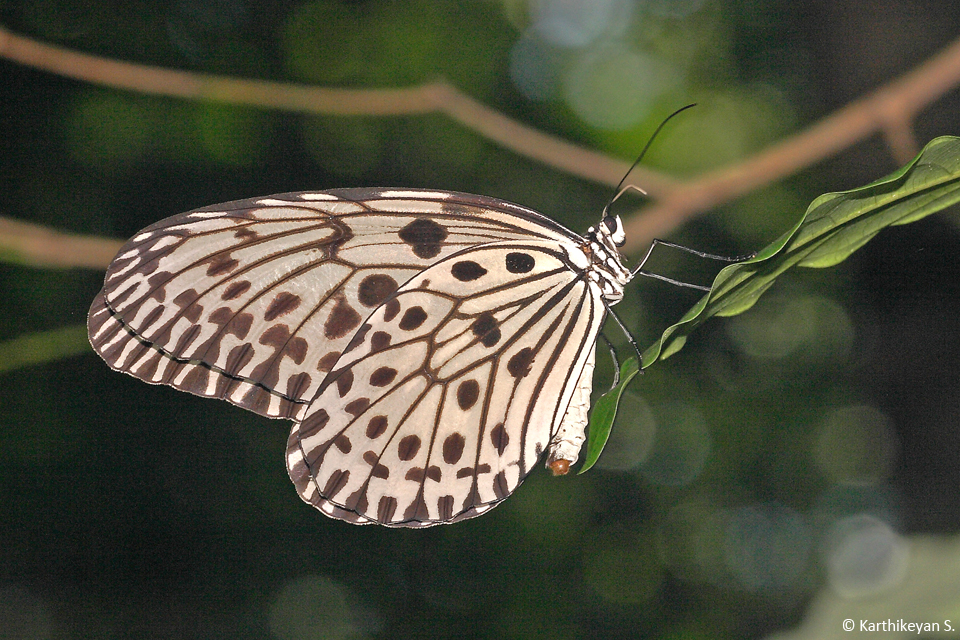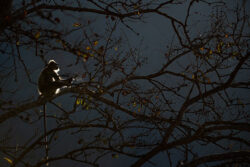Old Magazine House is definitely heaven — where else would you be woken up by the call of the Malabar Whistling Thrush? Ganeshgudi, a birders’ paradise located near the Londa – Dandeli road, is one of the finest moist-deciduous forests of the Western Ghats. These forests support a wonderful assortment of wildlife. One could get completely immersed in layers of Teak, Mango and Rosewood trees, complemented with shorter trees and evergreen foliage. This provides the perfect ecosystem for butterflies, which form an important part of the food chain. Out of the 332 species of butterflies recorded in the Western Ghats, 36 are endemics.
Though the Western Ghats covers less than 5% of India’s land area, it has over 30% of the country’s plant, bird and mammal species. The rich biodiversity of the region has made its conservation important and UNESCO has listed it as a World Heritage Site.
Here is a photo-essay on these beautiful butterflies found in Ganeshgudi.

Dark Wanderer (Pareronia ceylanica): The pale blue and the black of the male butterfly are difficult to miss. Early mornings, when this butterfly opens its wings to sun itself, is an ideal time to appreciate its beauty and photograph it. The female mimics the inedible Blue Tiger.

Cruiser (Vindula erota): Cruiser butterflies have a strong flight. Their wings span nearly 2.5 inches. Males and females look different. They can sometimes be seen coming to flowers.

Common Pierrot (Castalius rosimon): It belongs to the family Lycaenidae. Lycaenids are small-sized butterflies commonly known as blues. They usually possess tail-like projections on their hind wings. Ants tend to the larvae of many species of this family of butterflies. The association between the ants and the larvae of Lycaenidae is well-known.
Common Bluebottle (Graphium sarpedon ): The males are known for their habit of feeding by the edges of puddles. Mud-puddling individuals often spend a long time on damp patches, where they suck salts along-with water.

Common Pierrot (Castalius rosimon): It belongs to the family Lycaenidae. Lycaenids are small-sized butterflies commonly known as blues. They usually possess tail-like projections on their hind wings. Ants tend to the larvae of many species of this family of butterflies. The association between the ants and the larvae of Lycaenidae is well-known.

Chocolate Pansy (Junonia iphita): It belongs to the family Nymphalidae. Pansies are sun-loving butterflies. They also often visit flowers. The Chocolate Pansy is often seen on road-sides and clearings in forests.

Malabar Tree Nymph (Idea malabarica): This is a large butterfly found in peninsular India, that belongs to the Danaid group of the family Nymphalidae. It is found in forest clearings. They can also be seen sailing lazily above the forest canopy.

Psyche (Leptosia nina): This is a small butterfly of the family Pieridae. The upper forewing has a black spot on a mainly white background. Their flight is weak and erratic and the body of the butterfly bobs up and down as it beats its wings. They fly low, over grass and shrubs.

The Gladeye Bushbrown (Mycalesis patnia): It is an endemic species of the evergreen and heavy deciduous forests of South India. These are somber-coloured butterflies with a large eye-like marking, giving them their name. They are generally weak fliers, preferring to fly close to the ground.

The Monkey Puzzle (Rathinda amor): It has three white-tipped tails on each hind wing. This little butterfly has a very weak flight and does not fly long distances. It alights often, providing ample opportunities to observe and photograph it.

Tawny Coster (Acraea violae): This exudes an oily and smelly yellow liquid when handled, and is unpalatable to birds and most insects. This keeps them safe, despite their slow and weak flight. They frequently visit flowers.

Great Eggfly (Hypolimnas bolina ): These are large handsome butterflies. The males and females look different. The males have a large area of iridescent blue on the white patches on the upper-side. The females mimic the Common Indian crow, which are inedible.

Great Orange Tip (Hebomoia glaucippe): This is the largest of the butterfly family Pieridae, found in Asia. Aptly named, it bears bright, white wings on the upper-side, with a bright orange area at the apex of the forewings. In stark contrast to the bright, showy, upper surfaces, the under-sides mimic the appearance of a dried leaf. When at rest, with wings folded upright, the butterfly is well-camouflaged from predators.

Water Snow Flat (Tagiades litigiosa): This is a skipper butterfly which belongs to the family Hesperiidae. The adults are quick flyers and do not fly very high from the ground. Spotting them is difficult as they rest underneath leaf surfaces. They feed on nectar from flowers during mornings.





Instagram
junglelodgesjlr